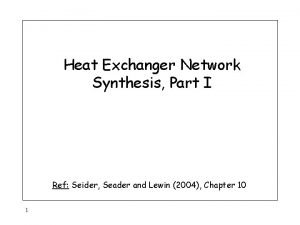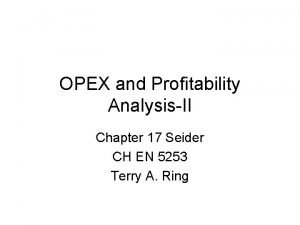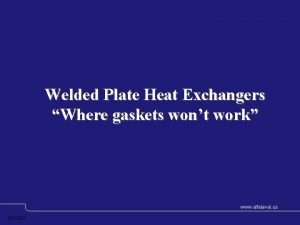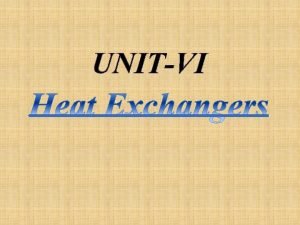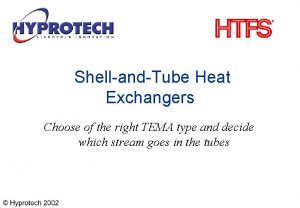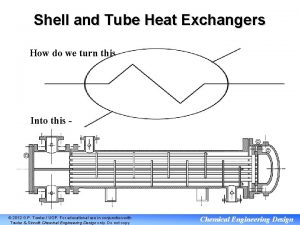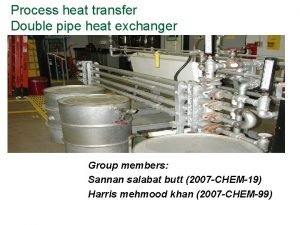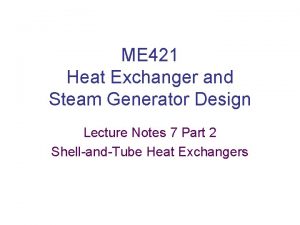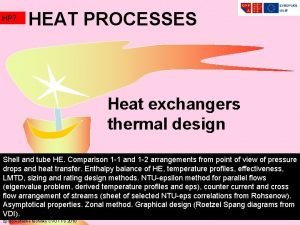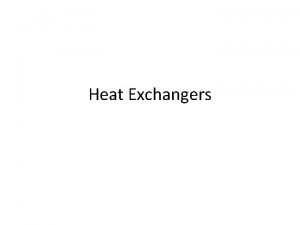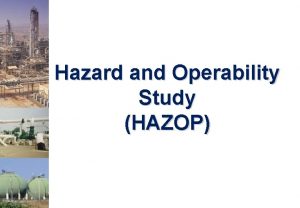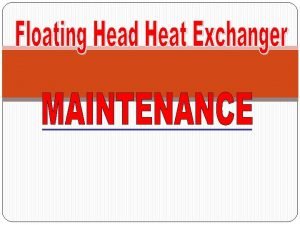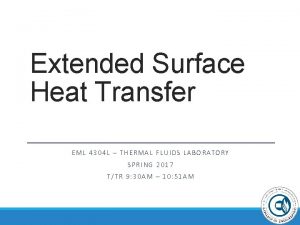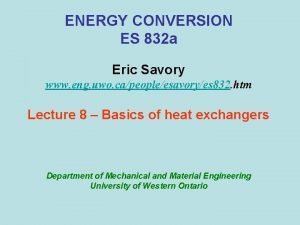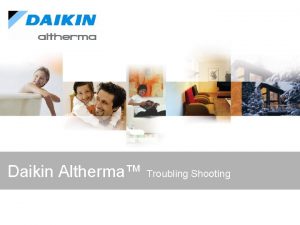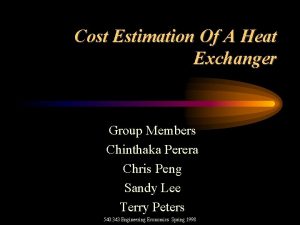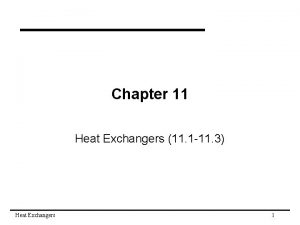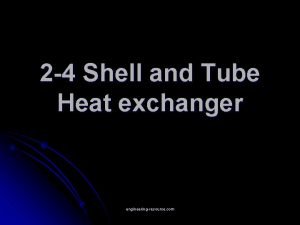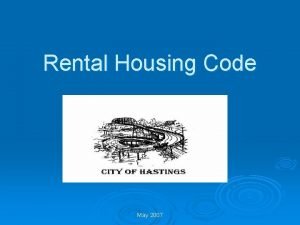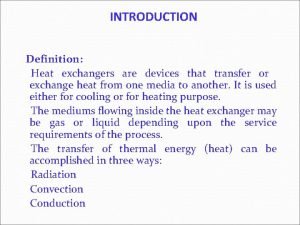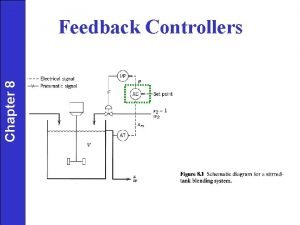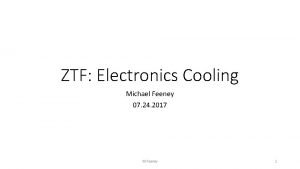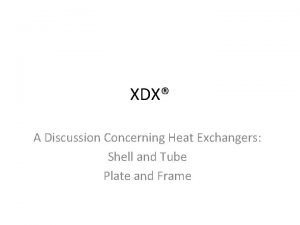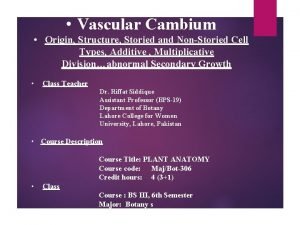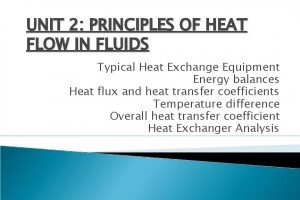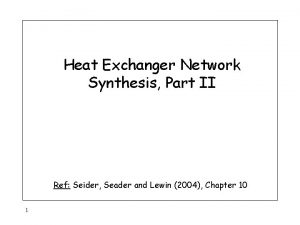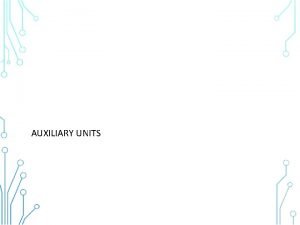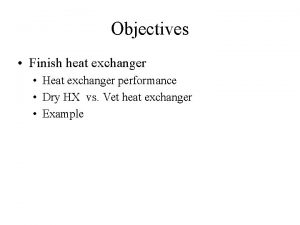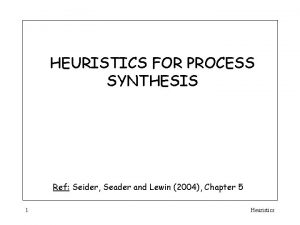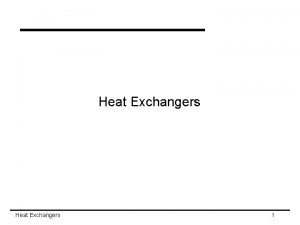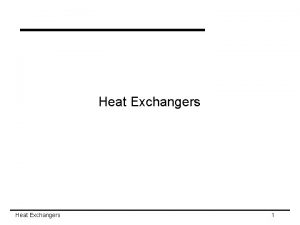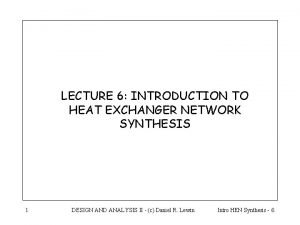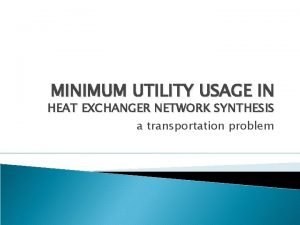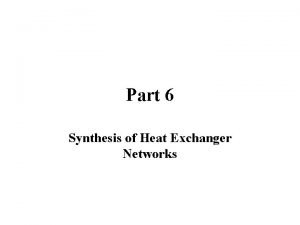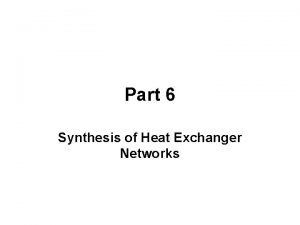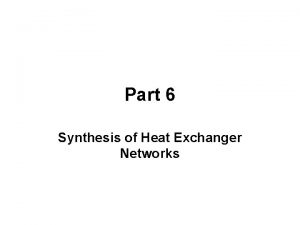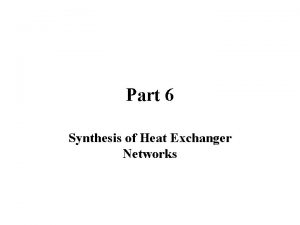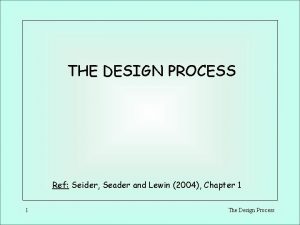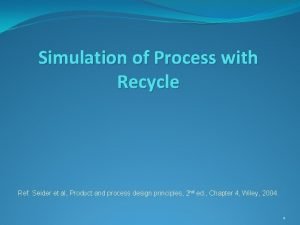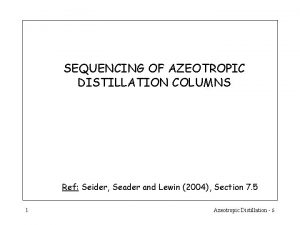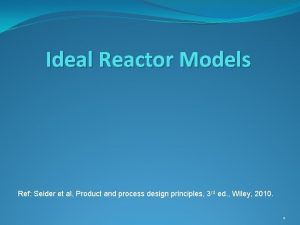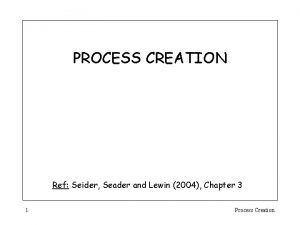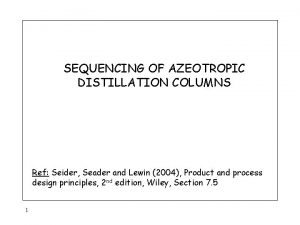Heat Exchanger Network Synthesis Part I Ref Seider





![Numerical Example Design A: (AREA) = 20. 4 [ A = Q/U Tlm ] Numerical Example Design A: (AREA) = 20. 4 [ A = Q/U Tlm ]](https://slidetodoc.com/presentation_image_h/d6116573581b0c4a33cf83c18dc914ca/image-6.jpg)
























- Slides: 30

Heat Exchanger Network Synthesis, Part I Ref: Seider, Seader and Lewin (2004), Chapter 10 1

Typical preheat train in refineries 2

Introduction - Capital vs. Energy • The design of Heat Exchanger Networks deals with the following problem: • Given: – NH hot streams, with given heat capacity flowrate, each having to be cooled from supply temperature THS to targets THT. – NC cold streams, with given heat capacity flowrate, each having to be heated from supply temperature TCS to targets TCT. • Design: An optimum network of heat exchangers, connecting between the hot and cold streams and between the streams and cold/hot utilities (furnace, hot-oil, steam, cooling water or refrigerant, depending on the required duty temperature). • What is optimal? Implies a trade-off between CAPITAL COSTS (Cost of equipment) and ENERGY COSTS (Cost of utilities). 3

Introduction - Capital vs. Energy • The design of Heat Exchanger Networks deals with the following problem: • Given: – NH hot streams, with given heat capacity flowrate, each having to be cooled from supply temperature THS to targets THT. – NC cold streams, with given heat capacity flowrate, each having to be heated from supply temperature TCS to targets TCT. • Design: An optimum network of heat exchangers, connecting between the hot and cold streams and between the streams and cold/hot utilities (furnace, hot-oil, steam, cooling water or refrigerant, depending on the required duty temperature). • What is optimal? Implies a trade-off between CAPITAL COSTS (Cost of equipment) and ENERGY COSTS (Cost of utilities). 4

Example Network for minimal equipment cost ? Network for minimal energy cost ? 5
![Numerical Example Design A AREA 20 4 A QU Tlm Numerical Example Design A: (AREA) = 20. 4 [ A = Q/U Tlm ]](https://slidetodoc.com/presentation_image_h/d6116573581b0c4a33cf83c18dc914ca/image-6.jpg)
Numerical Example Design A: (AREA) = 20. 4 [ A = Q/U Tlm ] Design B: (AREA) = 13. 3 6

DTmin - Example Tmin = Lowest permissible temperature difference Which of the two counter-current heat exchangers illustrated below violates T 20 o. F (i. e. Tmin = 20 o. F) ? 20 o 30 o 10 o 20 o Clearly, exchanger A violates the Tmin constraint. 7

Class Exercise 1 Tmin = 10 o. C Utilities. Steam@150 o. C, CW@25 o. C Design a network of steam heaters, water coolers and exchangers for the process streams. Where possible, use exchangers in preference to utilities. . 8

Setting Energy Targets Summary of proposed design: Are 60 k. W of Steam Necessary? 9

The Temperature-Enthalpy Diagram One hot stream 10 Two hot streams

The Composite Curve Hot Composite Curve 11

The Composite Curve (Cont’d) Cold Composite Curve 12

The Composite Curve (Cont’d) Result: QCmin and QHmin for desired Tmin MER Target Here, hot pinch is at 70 o. C, cold pinch is at 60 o. C QHmin = 48 k. W and QCmin = 6 k. W Method: manipulate hot and cold composite curves until required Tmin is satisfied. This defines hot and cold pinch temperatures. 13

The Pinch +x x +x The “pinch” separates the HEN problem into two parts: – Heat sink - above the pinch, where at least QHmin utility must be used – Heat source - below the pinch, where at least QCmin utility must be used. 14

The Problem Table Example: Tmin = 10 o. F. Step 1: Temperature Intervals (subtract Tmin from hot temperatures) Temperature intervals: 250 F 240 F 235 F 180 F 150 F 120 F 15

The Problem Table (Cont’d) Step 2: Interval heat balances For each interval, compute: Hi = (Ti Ti+1) ( CPHot CPCold ) 16

The Problem Table (Cont’d) Step 3: Form enthalpy cascade. This defines: Cold pinch temp. = 180 o. F QHmin = 500 k. Btu/h QCmin = 600 k. Btu/h 17

HEN Representation with the Pinch The pinch divides the HEN into two parts: the left hand side (above the pinch) the right hand side (below the pinch) At the pinch, ALL hot streams are hotter than ALL cold streams by Tmin. 18

Class Exercise 2 • • • 19 For this network, draw the grid representation Given pinch temperatures at 480 o. C /460 o. C, and MER targets: QHmin= 40, QCmin= 106, redraw the network separating the sections above and below the pinch. How many energy can be recovered?

Class Exercise 2 - Solution • • pinch temperatures; 480 o. C /460 o. C MER targets: QHmin= 40, QCmin= 106 C 116 H 40 H 10 210 170 20 100

Class Exercise 2 - Solution (Cont’d) This can be fixed by reducing the cooling duty by 10 units, and eliminate the excess 10 units of heating below the pinch. 21

Design for Maximum Energy Recovery Example Step 1: MER Targeting. Pinch at 90 o (Hot) and 80 o (Cold) Energy Targets: Total Hot Utilities: 20 k. W Total Cold Utilities: 60 k. W 22

Design for MER (Cont’d) Step 2: Divide the problem at the pinch 23

Design for MER (Cont’d) Step 3: Design hot-end, starting at the pinch: Pair up exchangers according to CP-constraints. Immediately above the pinch, pair up streams such that: CPHOT CPCOLD (This ensures that TH TC Tmin) Tmin 24

Design for MER (Cont’d) Step 3 (Cont’d): Complete hot-end design, by ticking-off streams. QHmin = 20 k. W H 20 90 240 Add heating utilities as needed ( MER target) 25

Design for MER (Cont’d) Step 4: Design cold-end, starting at the pinch: Pair up exchangers according to CP-constraints. Immediately below the pinch, pair up streams such that: CPHOT CPCOLD (This ensures that TH TC Tmin) Tmin 26

Design for MER (Cont’d) Step 4 (Cont’d): Complete cold-end design, by ticking-off streams. C 60 QCmin = 60 k. W 35 o 90 30 Add cooling utilities as needed ( MER target) 27

Design for MER (Cont’d) Completed Design: Note that this design meets the MER targets: QHmin = 20 k. W and QCmin = 60 k. W 28

Design for MER (Cont’d) Design for MER - Summary: MER Targeting. Define pinch temperatures, Qhmin and QCmin Divide problem at the pinch Design hot-end, starting at the pinch: Pair up exchangers according to CP-constraints. Immediately above the pinch, pair up streams such that: CPHOT CPCOLD. “Tick off” streams in order to minimize costs. Add heating utilities as needed (up to Q Hmin). Do not use cold utilities above the pinch. Design cold-end, starting at the pinch: Pair up exchangers according to CP-constraints. Immediately below the pinch, pair up streams such that: CPHOT CPCOLD. “Tick off” streams in order to minimize costs. Add heating utilities as needed (up to Q Cmin). Do not use hot utilities below the pinch. m Done! 29

Class Exercise 3 Tmin = 10 o. C. Utilities: Steam@150 o. C, CW@25 o. C Design a network of steam heaters, water coolers and exchangers for the process streams. Where possible, use exchangers in preference to utilities. 80 o. C QHmin=48 40 30 43 o. C H H 8 120 100 54 C 6 QCmin=6
 Heat exchanger network synthesis
Heat exchanger network synthesis Seider db
Seider db Grid diagram heat exchanger network
Grid diagram heat exchanger network Plate frame heat exchanger
Plate frame heat exchanger Thermax heat exchanger
Thermax heat exchanger Tema standard for heat exchanger
Tema standard for heat exchanger Tema nomenclature
Tema nomenclature A double pipe heat exchanger
A double pipe heat exchanger Me 421
Me 421 Triangular pitch heat exchanger
Triangular pitch heat exchanger Counter flow heat exchanger
Counter flow heat exchanger Cmin heat exchanger
Cmin heat exchanger Hazop study for heat exchanger
Hazop study for heat exchanger Floating head cover heat exchanger
Floating head cover heat exchanger Extended surface heat exchanger
Extended surface heat exchanger Lmtd heat exchanger formula
Lmtd heat exchanger formula Finned double pipe heat exchanger
Finned double pipe heat exchanger Daikin discharge pipe thermistor
Daikin discharge pipe thermistor Heat exchanger cost estimation
Heat exchanger cost estimation Shell and tube surface condenser
Shell and tube surface condenser Cold plate design calculations
Cold plate design calculations 2-4 pass shell and tube heat exchanger
2-4 pass shell and tube heat exchanger Giannoni heat exchanger
Giannoni heat exchanger Cracked heat exchanger
Cracked heat exchanger Plate type exchanger
Plate type exchanger The controllers chapter 8
The controllers chapter 8 Parker heat exchanger
Parker heat exchanger Standard refrigeration heat exchanger
Standard refrigeration heat exchanger Water heat exchanger
Water heat exchanger Storied and non storied cambium biology discussion
Storied and non storied cambium biology discussion Parallel heat exchanger
Parallel heat exchanger
